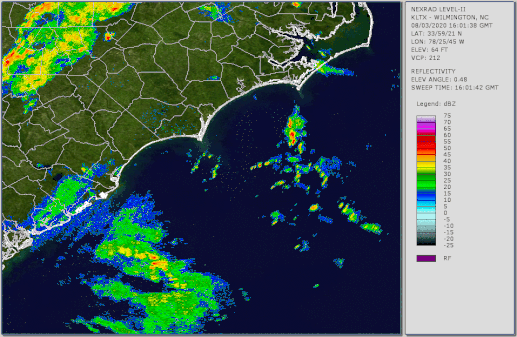As forecast, Isaías did briefly intensify to a Category 1 hurricane before making landfall near Myrtle Beach SC on Monday night. During the day on Tuesday, it accelerated northward through NC, VA, MD, PA, NY and will cross into Canada tonight as it transitions to an extratropical cyclone. It left the African coast on July 23rd -- twelve days ago -- but has spent only half that time as "Isaías".
Isaías is now the fifth named storm to make landfall on the continental US this season already... there have only been nine named storms in total, and it's only August 4th! This radar loop from Wilmington NC shows the evolution of the storm as it made landfall... this and many other radar loops of the storm are available at http://bmcnoldy.rsmas.miami.edu/tropics/radar/ -- including a 3-day loop than spans its trek from the Bahamas to Virginia.
As usual, rainfall is the greatest hazard posed by this landfalling tropical cyclone. Over the past three days, I have measured nearly 5 inches of rain at my house near Miami, but higher totals have been measured in the mid-Atlantic and northeast US states... preliminary estimates are in the 8-10 inch range in parts of MD and PA. Additionally, between Monday and Tuesday, there have been 27 tornado reports from North Carolina up into New Jersey.
Wilmington NC, which was hit by the eastern eyewall of the hurricane as it made landfall, experienced its largest storm surge in recorded history, beating the previous record set just two years ago by Hurricane Florence.
As of Tuesday afternoon (5pm local), Isaias is still a tropical storm with 65 mph peak sustained winds; it's centered near Albany NY and is racing toward the north-northeast at 40 mph. The list of tropical storms that have passed within 150 miles of where Isaias is on Tuesday afternoon is slim, but certainly includes ones you've heard of. The six most recent are Irene (2011), Gloria (1985), Frederic (1979), David (1979), Belle (1976), and Agnes (1972).
Invest 94L, which I've been mentioning for several days now, is located just south of Bermuda but is looking less and less likely to develop. Elsewhere, the Atlantic basin is quiet for the near future.
- Visit the Tropical Atlantic Headquarters.
- Subscribe to get these updates emailed to you.
- Follow me on Twitter




No comments:
Post a Comment